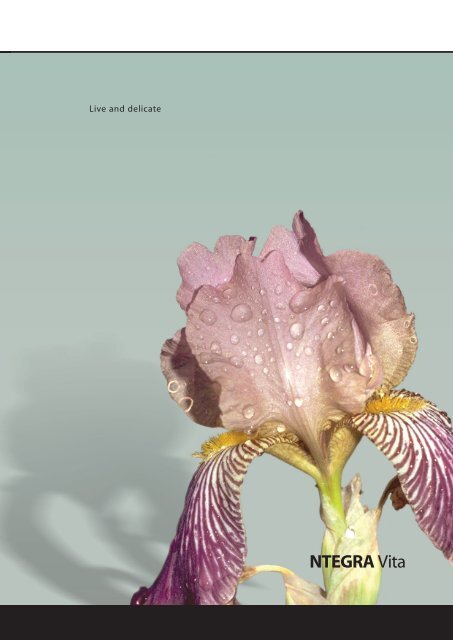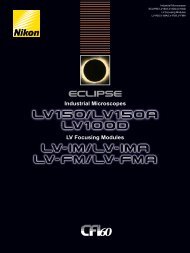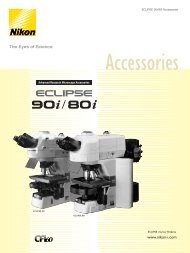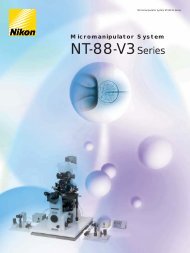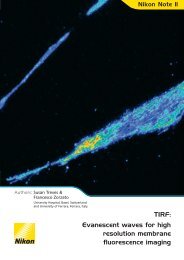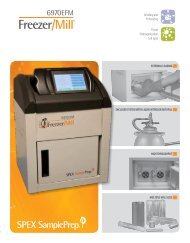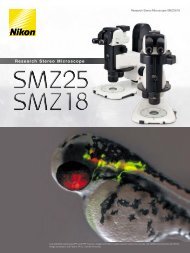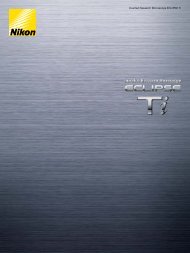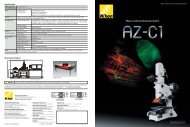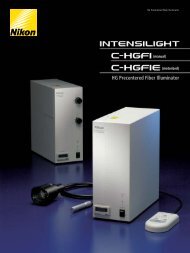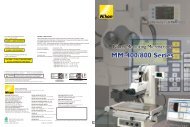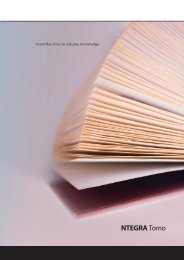NTEGRA Vita
NTEGRA Vita
NTEGRA Vita
You also want an ePaper? Increase the reach of your titles
YUMPU automatically turns print PDFs into web optimized ePapers that Google loves.
Live and delicate<br />
<strong>NTEGRA</strong> <strong>Vita</strong>
<strong>NTEGRA</strong> <strong>Vita</strong><br />
Life. Chemistry. Process.<br />
Good instrumentation makes it real.<br />
From molecules to living organisms, <strong>NTEGRA</strong> <strong>Vita</strong> opens the window to the world of biology and<br />
biochemistry. Especially designed to integrate seamlessly with your optical microscope, <strong>NTEGRA</strong> <strong>Vita</strong><br />
preserves the in situ environment so that you can observe, image and measure what is really there. Turn<br />
on <strong>NTEGRA</strong> <strong>Vita</strong> and concentrate on your experiment.Enjoy your work and so much expected results.Our<br />
system is not the most important thing here. It is just you who can achieve everything with <strong>NTEGRA</strong> <strong>Vita</strong>.<br />
32<br />
Copyright © NT-MDT, 2007
<strong>NTEGRA</strong> <strong>Vita</strong><br />
Maintaining stasis<br />
To maintain life and present the best conditions for<br />
measurement, most biological samples must be kept in fluid<br />
solutions. For conventional AFM biological imaging as<br />
well as biochemistry and bioorganic applications,<br />
<strong>NTEGRA</strong> <strong>Vita</strong> uses a unique sealed fluid cell which<br />
maintains an enclosed volume. Input/output pipes provide<br />
controlled flow of nutrient liquids and a heating element<br />
precisely maintains temperature, from room temperature to<br />
60°C, with an accuracy of ±0.005°C (typically). Made<br />
of chemically stable materials, the fluid cell can<br />
withstand aggressive solutions, including acids, bases, or<br />
salt solutions.<br />
From millimeters to angstroms<br />
Need to study live cells? <strong>NTEGRA</strong> <strong>Vita</strong> offers a special cell<br />
to hold standard Petri dishes. As with our sealed liquid cell,<br />
this system maintains liquid flow and temperature control.<br />
Most importantly, you can still use your inverted microscope<br />
for classic optical methods.<br />
With <strong>NTEGRA</strong> <strong>Vita</strong>, use fluorescence<br />
to image internal structures and the<br />
SPM to provide higher resolution<br />
surface detail or physical parameters<br />
such as membrane conductance or<br />
elasticity. Merge fluorescence and<br />
SPM images for further comparison.<br />
NT-MDT DualScan option expands<br />
the scan size up to 200x200x20 µm,<br />
giving you the opportunity to image<br />
either whole cells or even larger cell<br />
aggregates.<br />
Ultimate resolution<br />
requires ultra-small<br />
volumes<br />
Need the ultimate in resolution? You need "scanning-by-sample", a mode in which a small sample<br />
is scanned with great precision under a fixed probe. Our engineers have developed a special little<br />
fluid cell specifically for this<br />
application. This cell is also helpful<br />
when using expensive chemicals.<br />
From large format to ultrahigh<br />
resolution, <strong>NTEGRA</strong> <strong>Vita</strong> has a<br />
solution for your lab.<br />
Extremely small force<br />
measurements<br />
Measurements and analysis of<br />
probe-to-sample forces in pico- and<br />
nano- Newton range provide new<br />
insight into cellular properties.<br />
"Pushing" a cell with the probe then<br />
evaluating the cantilever deflection<br />
Temperature<br />
36,60 36,61 36,62 36,63 36,64 36,65 36,66 36,67 36,68 36,69<br />
Two curves obtained from very stiff (black<br />
line) and rather soft (blue line) materials.<br />
Delta of probe deflection shows the sample<br />
deformation by the probe. It can be<br />
transformed into the Young's modulus.<br />
A A DX=3.08 nm<br />
DNA cross-section draft.<br />
Temperature vs time. Overshoot is less than<br />
0.1°C when the chamber is heated from RT to<br />
36.6°C. Temperature fluctuations are less than<br />
0.02°C. Conditions suite perfectly working<br />
with living cells.<br />
500 600 700 800 900 1000 1100 1200 1300 1400 1500<br />
Time, sec<br />
36.62<br />
36.60<br />
provides qualitative information about the cell turgidity, cytoskeleton network rigidity, and<br />
cellular matrix density. "Touching" the surface-bound receptor molecules with a ligand-coated<br />
probe quantifies molecular interaction forces. <strong>NTEGRA</strong> <strong>Vita</strong> low noise closed loop sensors afford<br />
unprecedented accuracy of both probe movement and force measurements. Need even higher<br />
registration rate? Optional modules are available to achieve registration rate down to 10 -6 sec.<br />
Porcine kidney living cell. Difference in rigidity<br />
within a cell is estimated by Young's modulus<br />
(for comparison the Young's modulus value for the<br />
Petri dish surface underlying the cell was 1.4 GPa).<br />
Scan size: 28x28 µm.<br />
a.<br />
3.08 nm<br />
b.<br />
E = 5 kPa<br />
Unfolded DNA deposited on mica.<br />
AFM image obtained by DLC tip.<br />
DNA width 3.08 nm.<br />
Scan size 160x160 nm.<br />
E = 2.9 kPa<br />
Human embryo fibroblast (primary culture).<br />
(a) Phase contrast optical image of the cells,<br />
obtained during AFM scanning.<br />
(b) AFM image of the framed area. Semicontact<br />
mode in air. Scan size: 50x40x0.5 µm<br />
Copyright © NT-MDT, 2007 33
<strong>NTEGRA</strong> <strong>Vita</strong><br />
Scanning probe microscopy<br />
SPM methods<br />
in air & liquid<br />
in air only<br />
AFM (contact + semi-contact + non-contact) / Lateral Force<br />
Microscopy / Adhesion Force Imaging/ Force Modulation/ Phase<br />
Imaging/ AFM Lithography (scratching)/ Force-Distance curves<br />
STM/ Magnetic Force Microscopy/ Electrostatic Force Microscopy /<br />
Scanning Capacitance Microscopy/ Kelvin Probe Microscopy/<br />
Spreading Resistance Imaging/ Lithography: AFM (Current), STM<br />
Sample size<br />
XY sample<br />
positioning range<br />
Scan range<br />
Non-linearity, XY<br />
(with closed-loop sensors***)<br />
Noise level, Z<br />
(RMS in bandwidth 1000 Hz)<br />
Scanning by sample Scanning by probe*<br />
in air 40 mm, 15 mm in height 100 mm, 15 mm in height<br />
in liquid Up to 14x14x2.5 mm Up to 15x15x3 mm<br />
in air<br />
5x5 mm, 5 µm readable resolution, 2 µm sensitivity<br />
in liquid<br />
1x1 mm, 5 µm readable resolution, 2 µm sensitivity<br />
100x100x10 µm, 3x3x2.6 µm 100x100x10 µm, 50x50x5 µm<br />
Up to 200x200x20 µm** (DualScan mode)<br />


